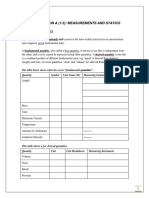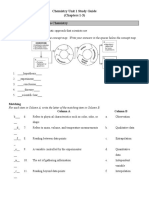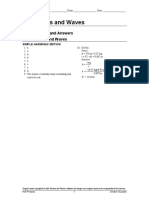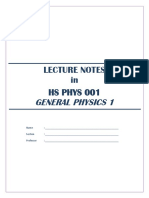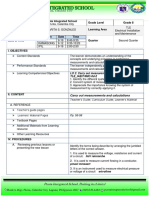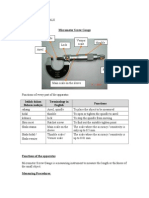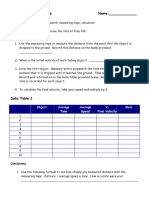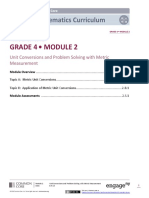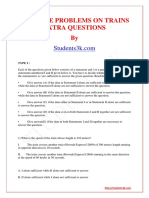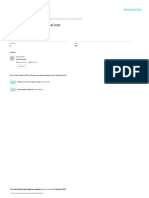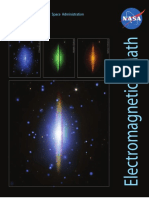Professional Documents
Culture Documents
Measurement Worksheet
Measurement Worksheet
Uploaded by
gregory jimenezOriginal Description:
Copyright
Available Formats
Share this document
Did you find this document useful?
Is this content inappropriate?
Report this DocumentCopyright:
Available Formats
Measurement Worksheet
Measurement Worksheet
Uploaded by
gregory jimenezCopyright:
Available Formats
Identification
EXERCISES Score:
Directions:
A: Identify if the given physical quantity is a fundamental or derived quantity.
1. density - __________________________
2. length - __________________________
3. luminous intensity - __________________________
4. displacement - __________________________
5. weight - __________________________
B. Identify if the given physical unit is a Metric System of English System of Unit.
6. meter - __________________________
7. kelvin - __________________________
8. pound - __________________________
9. yard - __________________________
10. mph - __________________________
Complete the table.
Quantity English SI Unit Metric SI unit
Example: length foot meter
1. mass
2. time
3. force
4. speed
5. acceleration
6. temperature
7. work
8. power
9. potential energy
10. impulse
11. torque
12. pressure
13. density
14. frequency
15. wavelength
Identification and
Problem Solving
Score:
________
A. Identify which situation shows systematic error or random error.
1. The flow of air causing the reading of the temperature to change from time to time.
2. A student uses a ruler and reads his measurement always on one side of the reading.
3. A volumetric cylinder that is used to measure the volume of the liquid has a bump on the cylinder.
4. An ammeter shows a current of 0.1 A before we link it to the circuit.
B: Solve the following problems about uncertainty. Use the back page for your complete solutions. You
can use extra sheet of paper if necessary. Expected answers are indicated to check your solutions.
1. (a) What is the percent uncertainty for the measurement given as 1.57 ± 0.1 m2, (b) 3.76 ± 0.05
m, and (c) 142.5 ± 0.15 L?
2. A bullet travels a distance of d =154 ± 0.05 m in the time t = 0.400 ± 0.001 s. What is the speed of
the bullet? (Speed = d/t) 0.03; 0.25
3. What is the area and approximate uncertainty of a triangle with a base of 3.1 mm ± 0.33% and a
height of 5.07 mm ± 0.15%? (hint: 𝐴=𝑏ℎ/2)
4. Find the mass of air in a living room with a 4.0 m ± 0.1% by 5.0 m ± 0.2% floor and a ceiling 3.0 m
± 0.01% high if the density of air is 1.20 kg/m3. (Hint: mass = density x volume).
5. A rectangle has a length of 4.50 ± 0. 01 in. and a width of 2.75 ± 0.05 in. (a) Determine its perimeter
and approximate uncertainty (hint: P = 2L + 2w). (b) Find the area of the rectangle and its
approximate uncertainty (hint: A = Lw).
You might also like
- IGCSE Physics Worksheet-MeasurementDocument8 pagesIGCSE Physics Worksheet-Measurementgdsuta88% (42)
- As PhysicsDocument227 pagesAs PhysicsGhadaYousefAwad100% (5)
- Form 4 Chapter 1 PhysicsDocument19 pagesForm 4 Chapter 1 PhysicsAngie Kong Su MeiNoch keine Bewertungen
- Fuel Managment System Book PDFDocument11 pagesFuel Managment System Book PDFhamrash100% (1)
- Adapted Measurement Lesson PlanDocument5 pagesAdapted Measurement Lesson Planapi-237083317Noch keine Bewertungen
- Gen. Physics 1 Module-Week 1 and 2Document24 pagesGen. Physics 1 Module-Week 1 and 2Jacko Leno100% (5)
- Metric-Scientific-Method-and-Graphing-study-guide-KEY 2Document8 pagesMetric-Scientific-Method-and-Graphing-study-guide-KEY 2penguin.21Noch keine Bewertungen
- Teacher Notes and Answers 11 Vibrations and WavesDocument3 pagesTeacher Notes and Answers 11 Vibrations and WavesPLAYVONoch keine Bewertungen
- Physics Manual Upper Level Educational InstituteDocument89 pagesPhysics Manual Upper Level Educational InstituteTiana MorrisonNoch keine Bewertungen
- GP1 Q1 W1 SLK1 Units and MeasurementsDocument32 pagesGP1 Q1 W1 SLK1 Units and MeasurementsJC VillartaNoch keine Bewertungen
- 1 Module 1 q1 General Physics 1Document17 pages1 Module 1 q1 General Physics 1ChandaNoch keine Bewertungen
- 4 Parallel Assessment Math 7 I. Multiple Choice: Read The Direction Each Item Carefully. Write Your Answer On The Space ProvidedDocument2 pages4 Parallel Assessment Math 7 I. Multiple Choice: Read The Direction Each Item Carefully. Write Your Answer On The Space ProvidedKristine Mae LargoNoch keine Bewertungen
- Stem12 Physics 1 q1 w1 LeapDocument4 pagesStem12 Physics 1 q1 w1 LeapGreg Aeron Del MundoNoch keine Bewertungen
- Teacher Notes and Answers 11 Vibrations and WavesDocument3 pagesTeacher Notes and Answers 11 Vibrations and WavesPLAYVO100% (1)
- Module Chapter 1 TeacherDocument26 pagesModule Chapter 1 TeacherhidayahnurulNoch keine Bewertungen
- EIM 11 - Q1 - W6 - Mod6Document14 pagesEIM 11 - Q1 - W6 - Mod6Mark Anthony BagaindocNoch keine Bewertungen
- Measurements and Experimentation: Unit 1 Exercise 1 (A) Objective QuestionsDocument49 pagesMeasurements and Experimentation: Unit 1 Exercise 1 (A) Objective QuestionsbaaNoch keine Bewertungen
- U1 Test Study Guide Hon - 17Document2 pagesU1 Test Study Guide Hon - 17api-368121935Noch keine Bewertungen
- Tatabunan Integrated School Talalora Samar THIRD Periodical Examination Science - Grade 7Document2 pagesTatabunan Integrated School Talalora Samar THIRD Periodical Examination Science - Grade 7Tinay Tinay100% (1)
- Properties of Matter Test ReviewDocument9 pagesProperties of Matter Test ReviewAngel PeayNoch keine Bewertungen
- Mathematics: Department of EducationDocument12 pagesMathematics: Department of EducationRou Gee100% (1)
- Answer Sheet For Activity 2Document7 pagesAnswer Sheet For Activity 2Michael Angelo ReyesNoch keine Bewertungen
- Module 2 Thermodynamics Discussion OnlyDocument17 pagesModule 2 Thermodynamics Discussion OnlyFrellian May CuestaNoch keine Bewertungen
- Chapter 1Document84 pagesChapter 1Isabelle LohNoch keine Bewertungen
- Physics: Carry Out A Scientific InvestigationDocument19 pagesPhysics: Carry Out A Scientific InvestigationMEENA A/P PERUMAL MoeNoch keine Bewertungen
- Teacher Notes and Answers 11 Vibrations and WavesDocument3 pagesTeacher Notes and Answers 11 Vibrations and WavesMuhammadNoch keine Bewertungen
- General Physics Lesson Plan-MeasurementDocument12 pagesGeneral Physics Lesson Plan-Measurementjoebert esculturaNoch keine Bewertungen
- Exemplar Physics Week 1 StudentsDocument24 pagesExemplar Physics Week 1 StudentsShaman KingNoch keine Bewertungen
- Hsphys001 LecturesDocument33 pagesHsphys001 LecturesEkis KaNoch keine Bewertungen
- Experiment 6 9Document14 pagesExperiment 6 9Danise CanoNoch keine Bewertungen
- School Punta Integrated School Grade Level Grade 8 Teacher Learning AreaDocument4 pagesSchool Punta Integrated School Grade Level Grade 8 Teacher Learning AreaMayeth Silva GonzalesNoch keine Bewertungen
- Speed of Waves LabDocument4 pagesSpeed of Waves Lablucasrende10Noch keine Bewertungen
- General Physics 1 1st Quarter Module 1 ActivitiesDocument16 pagesGeneral Physics 1 1st Quarter Module 1 ActivitiesMica LopezNoch keine Bewertungen
- Generalphysics1 q1 Mod1 Measurement-Properties-And-Physical-Quantities v1Document32 pagesGeneralphysics1 q1 Mod1 Measurement-Properties-And-Physical-Quantities v1Park JiminshiiNoch keine Bewertungen
- Answer Key PDFDocument199 pagesAnswer Key PDFEmilio José SelvaNoch keine Bewertungen
- General Physics 1: Quarter 1 - Module 1Document24 pagesGeneral Physics 1: Quarter 1 - Module 1Saiza BarrientosNoch keine Bewertungen
- Senior General Physics 1 Module 1 For PrintingDocument26 pagesSenior General Physics 1 Module 1 For PrintingPaula Camille VegaNoch keine Bewertungen
- Chapter 1 MaterialsDocument31 pagesChapter 1 MaterialsFahmi AmiNoch keine Bewertungen
- Physics Module 1Document14 pagesPhysics Module 1Nita Dela CruzNoch keine Bewertungen
- General: Preparedby Mr. Gadisa KDocument54 pagesGeneral: Preparedby Mr. Gadisa Kyosef melkaNoch keine Bewertungen
- Gen Physics Module 1Document6 pagesGen Physics Module 1Ganilyn PoncianoNoch keine Bewertungen
- EIM-11_Q1_W6_Mod6Document15 pagesEIM-11_Q1_W6_Mod6Aris SalongaNoch keine Bewertungen
- Notes - Wk1To4 Boundary LayersDocument44 pagesNotes - Wk1To4 Boundary LayersYadia BootramNoch keine Bewertungen
- Gen. Physics 1 Module 1Document5 pagesGen. Physics 1 Module 1wencylle casilNoch keine Bewertungen
- GRADE 10 PHYSICS-Fluid-Mechanics-FinalDocument23 pagesGRADE 10 PHYSICS-Fluid-Mechanics-FinalkingabrahampalecpecNoch keine Bewertungen
- Calculating Free Fall LabDocument2 pagesCalculating Free Fall LabghayesNoch keine Bewertungen
- Measurements in Scientific Data GatheringDocument54 pagesMeasurements in Scientific Data Gatheringeriantipuesto01750Noch keine Bewertungen
- Physics Worksheets 1616645440Document12 pagesPhysics Worksheets 1616645440JatadharNoch keine Bewertungen
- A New Approach To I.C.S.E. Physics Part 1 For Class IxDocument135 pagesA New Approach To I.C.S.E. Physics Part 1 For Class Ixyash mahajanNoch keine Bewertungen
- General PhysicsDocument5 pagesGeneral PhysicsKrizza Solis CataloctocanNoch keine Bewertungen
- General Physics 2: M V B GDocument3 pagesGeneral Physics 2: M V B GLeonardo PigaNoch keine Bewertungen
- Math7 Q2 Module1Document13 pagesMath7 Q2 Module1Teacher ana100% (1)
- Activities OpticsDocument20 pagesActivities OpticsPrince Jaspher De TorresNoch keine Bewertungen
- Lab (Circular Motion)Document4 pagesLab (Circular Motion)manuelterciario789Noch keine Bewertungen
- Physics 1 ModuleDocument28 pagesPhysics 1 ModuleAlbert RoseteNoch keine Bewertungen
- F4Ch1Teacher IntroductionDocument19 pagesF4Ch1Teacher IntroductionNuramalina FauziNoch keine Bewertungen
- Module 1 Measurement Accuracy Precision and ErrorsDocument9 pagesModule 1 Measurement Accuracy Precision and ErrorsAbel CruzNoch keine Bewertungen
- Third Quarter-Module 1: Week1Document10 pagesThird Quarter-Module 1: Week1Mariel SalazarNoch keine Bewertungen
- Physics - 1 Iit MaterialDocument1,438 pagesPhysics - 1 Iit MaterialSHK sirasapalliNoch keine Bewertungen
- Unit 4 Guided NotesDocument10 pagesUnit 4 Guided NotesflyingmsNoch keine Bewertungen
- Measurement of Length - Screw Gauge (Physics) Question BankFrom EverandMeasurement of Length - Screw Gauge (Physics) Question BankNoch keine Bewertungen
- Math g4 m2 Full Module PDFDocument88 pagesMath g4 m2 Full Module PDFRic JalosNoch keine Bewertungen
- Daily Lesson Log: School Grade Level Quarter Learning Area Section and TimeDocument3 pagesDaily Lesson Log: School Grade Level Quarter Learning Area Section and TimePeterson Dela Cruz EnriquezNoch keine Bewertungen
- Additional Practice: Another Look!Document2 pagesAdditional Practice: Another Look!Moaz KhursheedNoch keine Bewertungen
- To Measure The Resistivity of The Material of A Wire: DiagramDocument2 pagesTo Measure The Resistivity of The Material of A Wire: DiagramMuhammad Arqam ZaheerNoch keine Bewertungen
- Sample University Physics Chapters 20160419Document299 pagesSample University Physics Chapters 20160419M HASIN ISHMAM JEET100% (1)
- Aptitude Problems On Trains 2 (WWW - Students3k.com)Document5 pagesAptitude Problems On Trains 2 (WWW - Students3k.com)SureshCoolNoch keine Bewertungen
- STEEL WORKS - FootingDocument4 pagesSTEEL WORKS - FootingOlivia OzneminNoch keine Bewertungen
- Soal Latihan InstrumentasiDocument1 pageSoal Latihan InstrumentasiM Fharys Arfandhy FNoch keine Bewertungen
- Semi Detailed Lesson Plan On DraftingDocument6 pagesSemi Detailed Lesson Plan On DraftingHannah Ruth Bautista100% (3)
- Exercise No 3Document2 pagesExercise No 3Abdul Majeed Dida-agunNoch keine Bewertungen
- Army Units of Measure and Converstion FactorsDocument3 pagesArmy Units of Measure and Converstion FactorsSpace_HulkerNoch keine Bewertungen
- EfeyrDocument50 pagesEfeyralchemist2000Noch keine Bewertungen
- Aug 19Document1 pageAug 19Kemberly GamaNoch keine Bewertungen
- MMSCFD ConversionDocument2 pagesMMSCFD ConversionvhiyoNoch keine Bewertungen
- SP4Document560 pagesSP4Anjali SahaniNoch keine Bewertungen
- Si System of Measurement and Si UnitsDocument13 pagesSi System of Measurement and Si UnitsRijan ShresthaNoch keine Bewertungen
- Motion and Measurement of Distances Class 6 Extra Questions ScienceDocument14 pagesMotion and Measurement of Distances Class 6 Extra Questions ScienceAranya KarraNoch keine Bewertungen
- NPL HistoryDocument24 pagesNPL HistoryMauroNoch keine Bewertungen
- (BOSCH汽车工程手册 第二版 2002) BOSCH Automotive Handbook 2002Document1,390 pages(BOSCH汽车工程手册 第二版 2002) BOSCH Automotive Handbook 2002James Jiang100% (1)
- Chatgpt Usage and Limitations: December 2022Document10 pagesChatgpt Usage and Limitations: December 2022eder rodriguesNoch keine Bewertungen
- The Mathematics of Electromagnetism - AwesomeDocument191 pagesThe Mathematics of Electromagnetism - AwesomeLeben100% (2)
- Yk 35uv SpecDocument2 pagesYk 35uv SpecHồ ThànhNoch keine Bewertungen
- NMP-015-2012 - EnglishDocument25 pagesNMP-015-2012 - EnglishJuan Carlos Ruiz HonoresNoch keine Bewertungen
- Sample Lesson Plan in Science 5 English InstructionDocument4 pagesSample Lesson Plan in Science 5 English InstructionFaye BazarteNoch keine Bewertungen
- Module 8 - Setting Out HZ Alignment - 10Document10 pagesModule 8 - Setting Out HZ Alignment - 10Hisham Abou HalimaNoch keine Bewertungen
- Land MeasurementsDocument4 pagesLand MeasurementsSivakumar BadireddyNoch keine Bewertungen
- Activity and Practicals Class 11 and 12Document19 pagesActivity and Practicals Class 11 and 12Sourav SamantNoch keine Bewertungen
- Oil Gauging Tape (Steel Dipping Tape) Brand: Rabone Chesterman, EnglandDocument1 pageOil Gauging Tape (Steel Dipping Tape) Brand: Rabone Chesterman, EnglandpeccNoch keine Bewertungen









